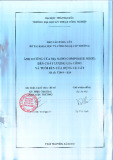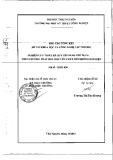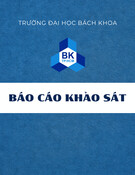
Hindawi Publishing Corporation
EURASIP Journal on Advances in Signal Processing
Volume 2007, Article ID 96747, 14 pages
doi:10.1155/2007/96747
Research Article
Wideband Impulse Modulation and Receiver Algorithms for
Multiuser Power Line Communications
Andrea M. Tonello
Dipartimento di Ingegneria Elettrica, Gestionale, e Meccanica (DIEGM), Universit`
a di Udine, Via delle Scienze 208,
33100 Udine, Italy
Received 8 November 2006; Accepted 23 March 2007
Recommended by Mois´
es Vidal Ribeiro
We consider a bit-interleaved coded wideband impulse-modulated system for power line communications. Impulse modulation
is combined with direct-sequence code-division multiple access (DS-CDMA) to obtain a form of orthogonal modulation and to
multiplex the users. We focus on the receiver signal processing algorithms and derive a maximum likelihood frequency-domain
detector that takes into account the presence of impulse noise as well as the intercode interference (ICI) and the multiple-access
interference (MAI) that are generated by the frequency-selective power line channel. To reduce complexity, we propose several
simplified frequency-domain receiver algorithms with different complexity and performance. We address the problem of the prac-
tical estimation of the channel frequency response as well as the estimation of the correlation of the ICI-MAI-plus-noise that is
needed in the detection metric. To improve the estimators performance, a simple hard feedback from the channel decoder is also
used. Simulation results show that the scheme provides robust performance as a result of spreading the symbol energy both in
frequency (through the wideband pulse) and in time (through the spreading code and the bit-interleaved convolutional code).
Copyright © 2007 Andrea M. Tonello. This is an open access article distributed under the Creative Commons Attribution License,
which permits unrestricted use, distribution, and reproduction in any medium, provided the original work is properly cited.
1. INTRODUCTION
The design of broadband communication modems for trans-
mission over power lines (PL) is an interesting and open
problem especially with reference to the development of reli-
able transmission and advanced signal processing techniques
that are capable of coping with the harsh properties of the
power line channel and noise [1]. In this paper, we deal
with advanced signal processing algorithms for a wideband
(beyond 20 MHz) impulse-modulated modem [2–4]. Up to
date, impulse modulation has only been considered for ap-
plication in ultra-wideband (UWB) wireless channels [5–7].
It has interesting properties in terms of simple baseband im-
plementation and robustness against channel frequency se-
lectivity and interference. Differently from the wireless con-
text, PL channels have a narrower transmission bandwidth
[8] and are characterized by several background disturbances
as colored and impulse noise [9]. Nevertheless, wideband im-
pulse modulation is an attractive scheme for application over
this medium as experimental trials have shown [4]. The basic
idea behind impulse modulation is to convey information by
mapping an information symbol stream into a sequence of
short-duration pulses. Pulses (referred to as monocycles) are
followed by a guard time to cope with the channel time dis-
persion. The monocycle can be designed to shape the occu-
pied spectrum and in particular to avoid the low frequencies
where we typically experience higher levels of background
noise. Since our system deploys a fractional bandwidth (ra-
tio between signaling bandwidth and center carrier) larger
than 20%, it can be classified as an ultra wideband system
according to the FCC. We consider indoor applications such
as local area networks, peripheral office connectivity, and
home/industrial automation. Impulse modulation is an at-
tractive transmission technique also for in-vehicle PLC sys-
tems and for PL pervasive sensor networks where the trans-
mitting nodes need to use a simple modulation scheme. In
general, we assume that a number of nodes (users) wish to
communicate sharing the same PL grid. Communication is
from one node to another node such that if other nodes
simultaneously access the medium, they are seen as poten-
tial interferers. In order to allow for users’ multiplexing, we
deploy direct-sequence code-division multiple access (DS-
CDMA) [6,10–12]. The user’s information is conveyed us-
ing a certain signature waveform that is a repetition of time-
delayed and weighted monocycles that span a transmission
frame.

2 EURASIP Journal on Advances in Signal Processing
y(t)y(nTc)yk(nTc)
Sampler
S/P
M-point
FTT
FD
detection
De-
interleaver
Viterbi
decoder
FD
parameters
estimation
Encode
and
interleave
Convolutional
encoder
Bit
interleaver
DS-CDMA
impulse
modulation
s(u)(t)PL
channel +
MAI
Noise
Front-end
filter
Figure 1: Impulse-modulated PL system with frequency-domain receiver processing and iterative decoding.
A key point in the proposed approach is that the sym-
bol energy is spread over a wideband which makes the sys-
tem robust to narrowband interference and capable of ex-
ploiting the channel frequency diversity. Furthermore, this
modulation approach is simple at the transmitter side and re-
quires a baseline correlation receiver that filters the received
signal with a template waveform [2,7].Thetemplatewave-
form has to be matched to the equivalent impulse response
that comprises the desired user’s waveform and the chan-
nel impulse response. To achieve high performance, this re-
ceiver requires accurate estimation of the channel which can
be complex if performed in the time domain [13,14]because
of the large time dispersion that is introduced by the wide-
band frequency-selective PL channel. Further, the channel-
frequency selectivity introduces intercode interference (ICI)
(interference among the codes that are assigned to the same
user) and multiple-access interference (MAI) when multiple
users access the network. This translates into performance
losses and suggests some form of multiuser detection or in-
terference cancellation. Therefore, in this paper we focus on
the receiver side and we propose a novel frequency-domain
(FD) detection approach which allows to obtain high per-
formance and to keep the complexity at moderate levels. FD
receivers have recently attracted considerable attention both
for equalization in single carrier systems [15] and in multi-
carrier (OFDM) systems [16,17]. We have investigated FD
processing in a UWB wireless system in [10], and described
preliminary results for the power line scenario in [11,12].
The contribution of the present paper is about the derivation
of a maximum likelihood joint detector that operates in the
frequency domain in the presence of MAI and impulse noise
(Section 3). The detection metric used in this receiver is con-
ditional on the knowledge of the channel of the desired user
and on the knowledge of the occurrence of the impulse noise.
From this receiver, with certain approximations, we de-
scribe in Section 4 several novel FD algorithms, in particular,
a simplified FD joint detector, an FD iterative detector, and
an FD interference decorrelator. They all include the capabil-
ity of adapting to impulse noise and rejecting the ICI/MAI,
but have different levels of performance and complexity.
We focus on the practical estimation of the parameters
that are needed in the detection algorithms (Section 5). In
particular, we address the FD channel estimation problem,
the estimation of the correlation of the noise and the inter-
ference, and the estimation of the impulse noise occurrence.
Frequency-domain channel estimation for the desired user
is done with a recursive least-squares (RLS) algorithm [18].
Further, channel coding is also considered and it is based
on bit-interleaved convolutional codes. In this case, we show
that iterative processing [19] with simple hard feedback from
the decoder allows to run the parameter estimators in a data
decision-driven mode which betters the overall receiver per-
formance.
Finally, we describe in Section 6 the key features of a PL
impulse-modulated modem that has been used to assess per-
formance and whose hardware prototype is described in [4].
To this respect, we propose the use of a wideband statisti-
cal channel model that allows to evaluate the system perfor-
mance by capturing the ensemble of indoor PL grid topolo-
gies.
2. WIDEBAND SYSTEM MODEL
Weconsiderasystemwhereanumberofnodes(users)com-
municate sharing the same PL network. Communication is
from one node to another, such that if other nodes simul-
taneously access the medium, they are seen as potential in-
terferers. The transmission scheme (Figure 1) uses wideband
impulse modulation combined with DS data spreading [11].
Users’ multiplexing is obtained in a CDMA fashion allocat-
ing the spreading codes among the users.
The signal transmitted by user ucan be written as
s(u)(t)=
k
i∈Cu
b(u,i)
kg(u,i)t−kTf,(1)
where g(u,i)(t) is the waveform (signature code) used to con-
vey the ith information symbol b(u,i)
kof user uthat is trans-
mitted during the kth frame. Each symbol belongs to the
pulse amplitude modulation (PAM) alphabet [18], and it

Andrea M. Tonello 3
c(u,i)
0··· c(u,i)
L−1
Tg
T
Tf
Figure 2: Frame format for user uand code i.
carries log2MSinformation bits where MSis the number
of PAM levels, for example, with 2-PAM b(u,i)
khas alphabet
{−1, 1}.Tfis the symbol period (frame duration) as shown
in Figure 2.Cudenotes the set of code indices that are allo-
cated to user u.Thus,userucan adapt its rate by transmitting
|Cu|=size{Cu}information symbols per frame.
The signature code (Figure 2) comprises the weighted
repetition of L≥1 narrow pulses (monocycles):
g(u,i)(t)=
L−1
m=0
c(u,i)
mgM(t−mT), (2)
where c(u,i)
m∈{−1, 1}are the codeword elements (chips), and
Tis the chip period. The monocycle gM(t) can be appropri-
ately designed to shape the spectrum occupied by the trans-
mission system. In this paper we consider the second deriva-
tive of the Gaussian pulse (Figure 3(a)). An interesting prop-
erty is that its spectrum does not occupy the low frequencies
where we experience higher levels of man-made background
noise (Figure 3(b)). Further, the symbol energy is spread over
a wideband which makes the system robust to narrowband
interference and capable of exploiting the channel frequency
diversity. Since the attenuation in PL channels increases with
frequency, we limit the transmission bandwidth to about
50 MHz using a pulse with D=126 nanoseconds. In typi-
cal system design, we choose the chip period T≥Dand we
further insert a guard time Tgbetween frames to cope with
the channel time dispersion (Figure 2). The frame duration
has, therefore, duration Tf=LT +Tg.
2.1. User multiplexing
Users are multiplexed by assigning distinct codes to distinct
users. In our design, the codes are defined as follows:
c(u,i)
m=c(u)
1,mc(i)
2,m,m=0, ...,L−1, i=0, ...,L−1, (3)
where {c(u)
1,m}is a binary (±1) pseudorandom sequence of
length Lallocated to user u, while {c(i)
2,m}is the ith binary
(±1) Walsh Hadamard sequence of length L[18]. With this
choice, each node can use all LWalsh codes, which yields
a peak data rate per user equal to R=L/Tfsymb/s. It ap-
proaches log2MS/T bit/s with long codes. While the signals
of a given user are orthogonal, the ones that belong to dis-
tinct transmitting nodes are not. The random code {c(u)
1,m}is
used to introduce code diversity and to randomize the effect
of the MAI.
2.2. Channel coding
We consider the use of bit-interleaved convolutional codes
(Figure 1)[18]. A block of information bits is coded, inter-
leaved, and then modulated. Interleaving spans a packet of
Nframes that we refer to as superframe. This coding ap-
proach yields good performance also in the presence of im-
pulse noise as it will be shown in the following.
2.3. Received signal
The signals that are transmitted by distinct nodes (users)
propagate through distinct channels with impulse response
h(u)(t). At the receiver of the desired node, we deploy a band-
pass front-end filter with impulse response gFE(t)=gM(−t)
that is matched to the transmit monocycle and that sup-
presses out-of-band noise and interference. Then, the output
signal in the presence of NIother users (interferers) reads
y(t)=
k
i∈C0
b(0,i)
kg(0,i)
EQ t−kTf+I(t)+η(t)
I(t)=
k
NI
u=1
i∈Cu
b(u,i)
kg(u,i)
EQ t−kTf−∆u,
(4)
where the equivalent impulse response for user uand sym-
bol i(equivalent signature code) is denoted as g(u,i)
EQ (t)=
g(u,i)∗h(u)∗gFE(t). It comprises the convolution of the signa-
ture code of indices (u,i) with the channel impulse response
of the corresponding user, and the front-end filter. The in-
dex u=0 denotes the desired user. ∆udenotes the time de-
lay of user uwith respect to the desired user’s frame timing.
I(t) is the MAI term, while η(t) denotes the additive noise.
The users experience distinct channels that introduce identi-
cal maximum time dispersion.
2.4. Noise models
In this paper, we consider the presence of background col-
ored and impulse noise [9]. Several impulse noise models
have been proposed in the literature. For instance, the class
A-B Middleton and the two-term Gaussian models [20,21]
have been used to characterize the probability density func-
tion (pdf) of the impulse noise. The temporal characteristics
of asynchronous (to the main cycle) impulse noise have been
modeled via Markov chains [9], or using a simple modifi-
cation of the two-term mixture model which assumes that
when a spike occurs, it lasts for a given amount of time [22].
In the receiver algorithms that we describe, differently from
other approaches, we do not use optimal metrics that are
based on the assumption of a stationary white noise pro-
cess with a given pdf, for example, [23,24]. In our approach

4 EURASIP Journal on Advances in Signal Processing
0 30 60 90 120
t(ns)
−0.5
0
0.5
1
g(t)
(a)
01020304050
f(MHz)
−50
−40
−30
−20
−10
0
|G(f)|(dB)
(b)
Figure 3: (a) Monocycle impulse response, gM(t)∼(1 −π((t−D/2)/T0)2)exp(−π/2((t−D/2)/T0)2), where D≈5.23T0is the monocycle
duration. (b) Monocycle frequency response.
(see Section 3), the receiver adapts to the impulse noise oc-
currence and treats it as a nonstationary colored Gaussian
process. To do so, as it will be explained, we need to estimate
the impulse noise occurrence and its locally stationary corre-
lation.
2.5. Statistical channel model
The frequency-selective PL channel is often modelled accord-
ing to [8], that is, we synthesize the bandpass frequency re-
sponse with NPmultipaths as
H+(f)=
NP
p=1
gpe−j(2πdp/v)fe−(α0+α1fK)dp,0≤B1≤f≤B2,
(5)
where |gp|≤1 is the transmission/reflection factor for path
p,dpis the length of the path, v=c/√εrwith cspeed of light,
and εr, dielectric constant. The parameters α0,α1,Kare cho-
sen to adapt the model to a specific network. To assess the
system performance, we may use this model once the refer-
ence parameters are chosen. Instead, we propose to evaluate
performance with a statistical model that allows to capture
the ensemble of PL grid topologies. It is obtained by consid-
ering the parameters in (5) as random variables. Then, we
generate channel realizations through realization of the ran-
dom parameters. We assume the reflectors (that generate the
paths) to be placed over a finite distance interval. We fix the
first reflector at distance d1and we assume the other reflec-
tors to be located according to a Poisson arrival process with
intensity Λ[m−1]. The reflection factors gpare assumed to
be real, independent, and uniformly distributed in [−1, 1].
Finally, we appropriately choose α0,α1,Kto a fixed value.
If we further assume K=1, the real impulse response can
be obtained in closed form. This allows to easily generate a
realization for user u(corresponding to a realization of the
random parameters NP,gp,dp) as follows:
h(u)(t)=2ReNP
p=1gpe−α0dp α1dp+j2πt−dp/v
α1dp2+4π2t−dp/v2
×ej2πB1(t−dp/v)−α1B1dp
−ej2πB2(t−dp/v)−α1B2dp.
(6)
We assume distinct users to experience independent chan-
nels, that is, the random parameters are independent for the
channels of distinct users, which is appropriate in indoor
PL channels due to the large number of path components.
The impulse responses are assumed to be constant for a
given amount of time and they change for a new (randomly
picked) topology.
3. DETECTION ALGORITHMS FOR THE IMPULSE-
MODULATED SYSTEM
In this section, we derive several detection algorithms that
operate in the frequency domain (FD). Their performance is
compared with the baseline correlation receiver as reported
in Section 6.
3.1. Baseline receiver
The baseline receiver for the impulse-modulated system is
the correlation receiver. Assuming binary data symbols, it
computes the correlation between the received signal y(t)
and the real equivalent impulse response g(0,i)
EQ (t). Thus, we
obtain the decision metric z(0,i)
DM (kTf)=Ry(t)g(0,i)
EQ (t−kTf)dt
for the ith symbol that is transmitted by user 0 in the
kth frame. Then, a threshold decision is made, that is,

Andrea M. Tonello 5
b(0,i)
k=sign{z(0,i)
DM (kTf)}. This baseline correlation receiver
is optimal when the background noise is white Gaussian and
there is perfect orthogonality among the received signature
codes [2]. To implement the correlation receiver, we need
to estimate the channel. Time-domain channel estimation
[3,13,14] is complicated due to the large time dispersion of
the PL channel that implies that g(0,i)
EQ (t)isaninvolvedfunc-
tion of the channel and the transmitted waveform. Further-
more, the correlation receiver suffers from the presence of
intercode interference (ICI) and multiple-access interference
(MAI) that is generated by the dispersive PL channel in the
presence of multiple users.
3.2. Maximum likelihood frequency-domain receiver
To improve the performance of the baseline receiver, we pro-
pose an FD signal processing approach. To derive the receiver
algorithms, we treat the noise as the sum of two Gaussian dis-
tributed processes. Similarly, the receiver treats the MAI as
Gaussian. Therefore, the overall impairment process is mod-
eled by the receiver as
z(t)=η(t)+I(t)=wT(t)+α(t)wIM(t)+I(t), (7)
where wT(t) is the thermal noise, wIM(t) is the impulse noise,
and I(t) is the MAI. The multiplicative process α(t)accounts
for the presence or absence of impulse noise. That is, at time
instant t, the random variable α(t)isaBernoullirandom
variable with parameter pand alphabet {0, 1}.Werefertoit
as Bernoulli process. All processes are treated as independent
zero-mean Gaussian, not necessarily stationary, with corre-
lation, respectively, as
κTτ1,τ2=EwTτ1wTτ2,
κIMτ1,τ2=EwIMτ1wIMτ2,
κIτ1,τ2=EIτ1Iτ2.
(8)
Conditional on the Bernoulli process, the impairment is a
Gaussian process with correlation
κz|ατ1,τ2|α(t), t∈R
=κWτ1,τ2+ατ1ατ2κIMτ1,τ2+κIτ1,τ2.
(9)
The Gaussian approximation for the MAI improves as the
number of interferers increases. The model used for the
overall noise contribution allows to capture both stationary
and nonstationary components of it. Further, it allows to de-
scribe impulse spikes of certain duration, power decay pro-
file, and colored spectral components.
To proceed, we assume discrete-time processing (Figure
1) such that the received signal is sampled with period Tc=
Tf/M,whereMis the number of samples/frame, to obtain
ynTc=
k
i∈C0
b(0,i)
kg(0,i)
EQ nTc−kTf+znTc.(10)
If we acquire frame synchronization with the desired user
and we assume that the guard time is sufficientlylongnot
to have interframe interference, that is, interference among
the symbols of adjacent frames, we can write
yknTc=
i∈C0
b(0,i)
kg(0,i)
EQ nTc−kTf,
+zknTcn=0, ...,M−1,
(11)
with yk(nTc)=y(kMTc+nTc), and zk(nTc)=z(kMTc+nTc),
k∈Z.
Under the colored Gaussian impairment model in (7),
and under the knowledge of both the channel and the
Bernoulli process α(t) (meaning that we assume to know
when the impulse noise occurs), the maximum likelihood
receiver searches for the sequence of transmitted symbols
b(0) ={b(0,i)
k,k∈Z,i∈C0}(belonging to the desired user) that
maximizes the logarithm of the probability density function
of the received signal y={...,y(0), y(Tc), ...}conditional
on a given hypothetical transmitted symbol sequence, that
is, log p(y|b(0)), [18,25].Itfollowsthatwehavetosearch
for the symbol sequence that minimizes the following log-
likelihood function1
Λb(0)
=
∞
l=−∞
∞
m=−∞ylTc
−
k
i∈C0
b(0,i)
kg(0,i)
EQ lTc−kTf
×K−1lTc,mTc
×ymTc−
k
i∈C0
b(0,i)
kg(0,i)
EQ mTc−kTf,
(12)
where K−1(lTc,mTc) is the element of indices (l,m) of the
matrix K−1, that is, the inverse of the correlation matrix of
the impairment vector z=[...,z(0), z(Tc), ...],
K=EzzT.(13)
The elements of Kare obtained by sampling (9) in the ap-
propriate time instants, that is,
K(lTc,mTc)=κz|α(lTc,mTc|α(t), t∈R).(14)
As an example, if we suppose the absence of MAI, the diag-
onal elements of Krepresent the power of the thermal plus
impulse noise, and they are typically large in the presence of
impulse noise.
The likelihood (12) can be written as the scalar product
Λ(b(0))=e†K−1e=e,K−1eif we define the vector e=
[...,e(0), e(Tc), ...]T,withe(lTc)=y(lTc)−ki∈C0b(0,i)
k×
g(0,i)
EQ (lTc−kTf). Since the scalar product is irrelevant to
an orthonormal transform (Parseval theorem), we have that
1(·)Tdenotes the transpose operator. (·)†denotes the conjugate and
transpose operator.


























